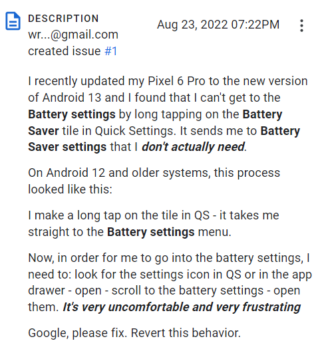Android 13 update has rolled out to Pixel devices and it will also be available for Samsung, Motorola, OnePlus, Xiaomi, Oppo and many more devices in the coming months.
Some of the cool new features include smart home controls on the lock screen, different languages for different apps, and much-needed privacy enhancements.
Android 13 changes long-tapping behaviour on Battery Saver tile
However, some Android 13 users are unhappy with the changes made by Google to the long-tapping behavior on the Battery Saver tile in the Quick Settings menu.

In Android 12 and older versions, users were able to access Battery settings by long-tapping the Battery Saver tile in the Quick Settings menu. However, this is no longer possible in Android 13.
Google has changed this behavior and now when you tap on the Battery Saver tile in the Quick Setting menu, it opens the Battery Saver settings and not the general Battery Settings menu as it did before.
Now, in order to go to battery settings, users need to look for the settings icon in Quick Search or in the app drawer. Then open it and scroll to the battery settings in order to open it. Some feel this process is longer.
It takes longer to access all battery settings from everywhere, unlike previous versions
Source
While it certainly is the right change from Google’s end (after all, the Battery Saver tile should actually open Battery Saver settings), some Pixel owners want it reverted.
It’s probably because Pixel owners have gotten used to the old way this feature worked, even if it was actually the incorrect execution, and are now struggling to get to gripes with the little tweak in Android 13.
Still, we’d like to know your thoughts on this Android 13 change via the comments section below.
Meanwhile, check out our Google Pixel Android 13 bug tracker for more insights into other issues.
PiunikaWeb started as purely an investigative tech journalism website with main focus on ‘breaking’ or ‘exclusive’ news. In no time, our stories got picked up by the likes of Forbes, Foxnews, Gizmodo, TechCrunch, Engadget, The Verge, Macrumors, and many others. Want to know more about us? Head here.



